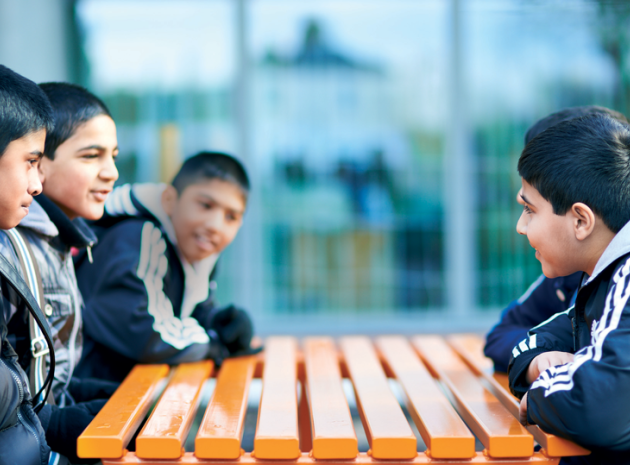In the first of a three-part series about making the most of your outside spaces, Juno Hollyhock looks at play equipment…
Mention the concept of ‘playing’ to anyone over the age of about eight and you’re likely to be faced with a look of aggrieved impatience. ‘I don’t PLAY, I’m far too old for that.’ So one needs to approach the sensitive subject of play equipment in secondary schools with a degree of caution. The main aim of primary children seems to be, on balance, to move around as much as possible. Sitting down is ’boring’ and when the bell rings for the end of break, the feet-shifting and fidgeting that accompanies the general effort to stand still while your class is called is indicative of high levels of unspent energy.
Secondary pupils however prefer to sit as soon as is practically possible. ‘Sit’ actually may be too neat a word – ‘drape’, ‘slouch’ or ‘loll’ is perhaps more appropriate. What this tells us is that seating is one of the most important pieces of play equipment to get right in a secondary school ground context as so much of students’leisure play will revolve around chatting, listening to music and generally putting the world, and each other’s relationships, to rights. The first, and easiest, thing to do is to go out on the next sunny day and look at where most of the pupils choose to sit at the moment. This will tell you where to locate benches for general relaxation (do not put any seated relaxation space anywhere near the inclusion room if you have one, the disruption will be absolute). Then you also need to see where your young people choose to go when it is windy, or raining (if they’re not shut up in some stuffy sock-smelling classroom somewhere). These are the areas where robust shelter needs to be considered if they are to continue to enjoy the grounds in less clement weather.
Play structures
I am always fascinated by how many older children hang around longingly like so many hungry orphans outside younger children’s play spaces. As soon as the last small child has been carted off for tea and bed, they descend on the roundabouts, the swings, the seesaws and the sandpit as though they haven’t played for years. They may not use them in the most traditional fashion but they are most certainly engaging in physical play. How often do we see this equipment in secondary schools? Should we reconsider how valuable it might be?
If a school decides to make an investment in a piece of fixed play equipment then I would always urge them to consider very carefully how versatile that piece of equipment might be. A swing really is only a swing and is limited to that use. Likewise a trampoline or a climbing wall, all of which I have seen imported and subsequently abandoned in secondary schools. This type of play equipment also requires a degree of supervision which is not always possible. Choosing fixed play equipment on a budget means getting something that will last a long time with the minimum of maintenance and ideally can be adapted to more than one purpose. Natural log climbing structures can lend themselves well to being sitting areas, performance areas, areas to hang swings from, display areas and also… oh yes… climbing structures. They can also benefit from being designed, and even constructed, by the pupils themselves.
Small equipment play
Older children are just as capable as younger ones of using their imagination and creating playable environments given the right resources. Tempting though it is to invest in a dozen footballs to be counted out and then counted back in again, it may be more beneficial to consider a more diverse range of small equipment to sit alongside this.
A few of the boxed games for outdoor play, such as Twister or large scale snakes and ladders or Scrabble can be invaluable for those small teams of pupils who otherwise will just hang around and get bored and into mischief. Make spare counters etc out of slices of wood as the original ones will be lost on the first time of opening the box.
Piles of wood and bricks with a few old tarpaulins and some rope are just as attractive to a year 8 pupil as they are to a year 3 in terms of the potential they have for den building. If the space allows then there is no reason why the judicious addition of a few hooks in walls shouldn’t allow some pretty inventive structures to emerge.
Space for chalk art can bring out the inner Leonardo whilst giving the aspiring Banksy a place to practise without decorating the side of the sports hall with profanities. It is always worth keeping a weather eye on what is being drawn – I well remember a group of previously less-than-angelic pupils being engaged in planting bulbs along the verge near their school as a punishment for graffiti. Quiet as mice and twice as docile they were an unexpectedly pleasant bunch to work with. Until the Spring came around and it was clear that the bulbs had been planted in a certain order…
However your pupils play, and whatever space they adopt to play in, it is always worth re-visiting that first point before you make any changes:
- What do you observe?
- What do they do naturally now?
- Where do they do it?
- How could that be enhanced with some landscape changes?
Keep it versatile, low maintenance and with low supervision requirements and, if at all possible, join in yourself with some of the play – it’s a great way to build and reinforce relationships.
About the author
Juno Hollyhock has been executive director at Learning Through Landscapes (LTL) since 2012. Become a member of LTL’s membership to gain access to the latest news in the outdoor learning sector, hundreds of downloadable guidance notes, lesson ideas and inspirational images PLUS access to LTL’s expert advice through email. All of this support to help you make a difference to your outside space for just £12 per year (plus VAT). Visit < ahref="http://ltl.org.uk/membership/member.php" target="_blank">ltl.org.uk/membership/member.php.











In the first of a three-part series about making the most of your outside spaces, Juno Hollyhock looks at play equipment…